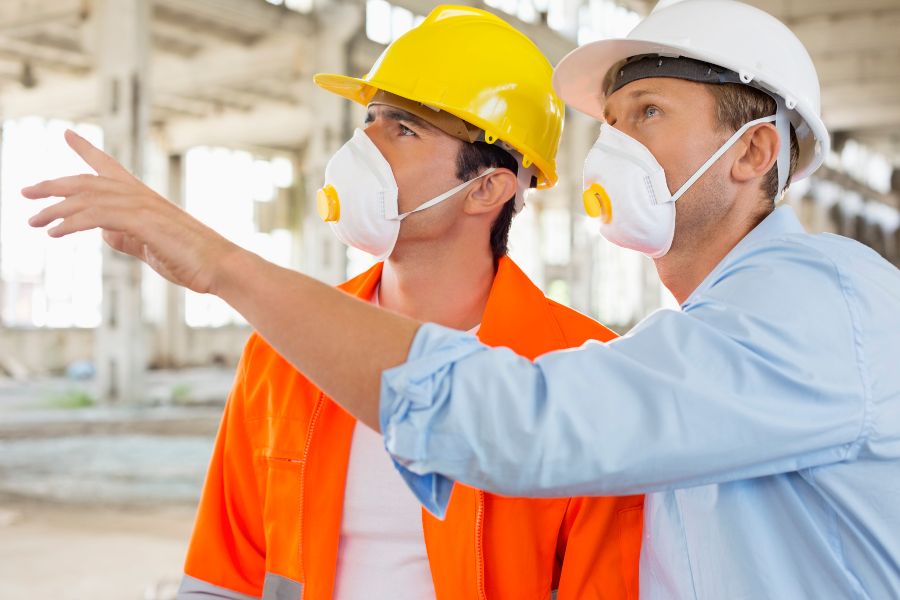Adhering to safety precautions within the construction industry is incredibly important. The safety of workers on the site must be a priority at all times. In order to maintain that safety, common safety requirements must be followed, such as those discussed below.
In addition to the regular safety standards on construction sites, 2020 has brought additional challenges in the form of COVID-19 precautions. Similar to those precautionary measures you may have already experienced at your local doctor’s office or grocery store, protection is required construction sites as well.
Excavation Sites
Excavation sites can present a number of dangers, from heavy equipment accidents to cave ins. All excavation and trench sites must be inspected by a professional. In addition, workers must wear approved hard hats at all times to prevent injuries from falling objects.
For excavations more than five feet deep additional precautions need to be taken. Protective systems must be in place. There must be access in and out of the excavation by a ramp or ladder. Heavy equipment must be kept at least two feet or more away from the edge of excavations to prevent cave ins.
Support Safety
Support safety centers on any equipment that lifts and supports workers off the ground. From heavy equipment like lifts to smaller tools like ladders and stairs, support safety is important.
Lifts under the majority of circumstances should have guardrails and must be in working order at all times. Workers should never overload ladders beyond their recommended capacity, nor walk beneath lifts or ladders to prevent injuries from falling items.
Fall Safety Systems
Fall protection must be in place on all construction sites. Even on sites where workers are not required to work off the ground, holes and trip hazards can still present fall opportunities.
Workers should familiarize themselves with the site whether working at height or on the ground. Knowing where hazards exist is an important step in avoiding them. For those working off the ground, ensure fall protection systems such as guardrails and lifelines are in place before working in the area. Additionally, ensure safety equipment is working as intended before using it.
Body Protection
Wearing appropriate body protection at construction sites is also important. Hard hats are recommended at all sites. Protective glasses and earplugs should always be worn on sites where eye and auditory hazards exist.
For example, any site where flying particles, chemicals, or light dangers (such as welding) exist should require workers to wear appropriate face protection.
COVID-19 Precautions
With the COVID-19 pandemic continuing to affect the globe, the World Health Organization continues to provide precautions trying to curb the spread of the virus. Many of these precautions apply to workers on construction sites and include the following:
Social Distancing
Since construction is an employment industry that cannot be easily operated from home and requires the workers’ physical presence, the employees are required to maintain 6 feet distancing from one another where possible while on the worksite.
Disinfecting and Proper Cleaning
Workers’ equipment, hands, and where possible their work area, should be properly sanitized. Frequently touched surfaces like doorknobs need to be cleaned using recommended disinfectants. Any shared equipment should be cleaned between uses.
Use of PPE
Personal protective equipment (that includes face masks, gloves, and additional protective clothing deemed necessary) is required to help prevent the virus spreading throughout a worksite. Employers should consider providing this equipment to their employees to ensure they are protected on the job.
Mandatory Health Screenings
One of the most commonly known symptoms of COVID-19 is a high fever. Construction project managers should consider having employees’ temperature recorded when they come on site, and send home anyone with a fever. If even one employee on a construction site tests positive for COVID-19, the rest of the crew must be considered exposed.
Checking daily temperatures is a simple step to helping ensure a project doesn’t fall behind schedule due to an entire crew having to self-isolate.
Looking for more tips to keep your construction site safe and your construction project on schedule? Contact T.F. Harper & Associates LP, a construction company offering contracting services in Austin TX, to learn more.





